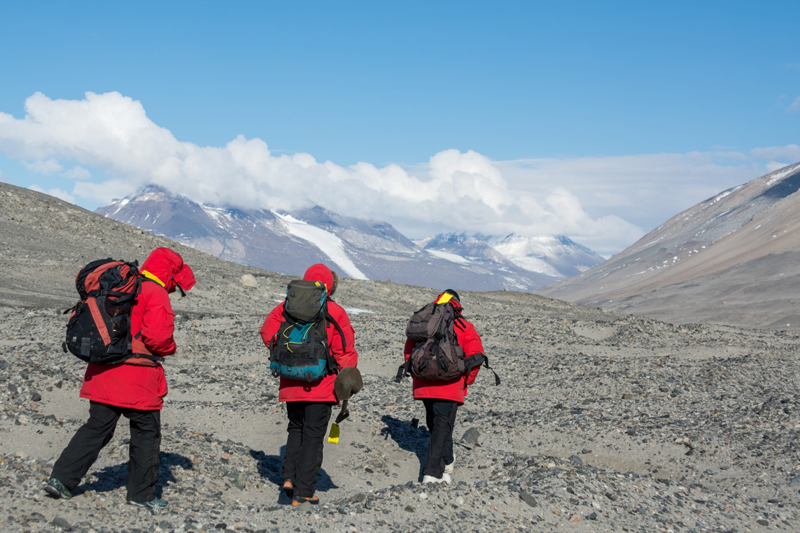A Chemical Detective Story: Why is Don Juan Pond So Salty?What Research on the Earth’s Saltiest Lake in the “Natural Laboratory” of Antarctica Might Tell Scientists About Water on MarsPosted June 13, 2018
During winter, nearly everything in Antarctica freezes solid. Except Don Juan Pond. 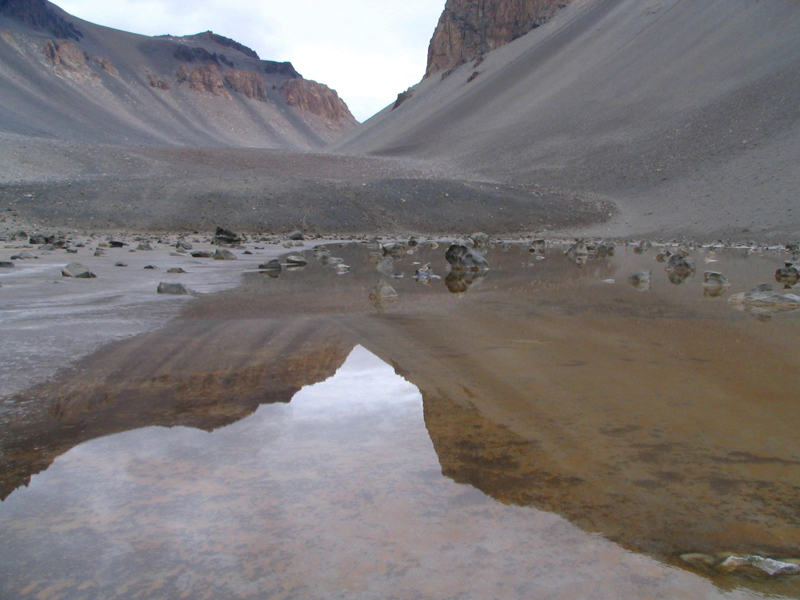
Photo Credit: Glen Snyder
The team camped near the shallow but salty Don Juan Pond for weeks while studying how water flows into the pond.
Though only about twice the area of an Olympic-sized swimming pool, and barely a foot deep, Don Juan Pond is famous for being the saltiest body of water on the entire planet. Its waters are so saturated with salt that it doesn’t fully freeze unless the temperature drops below minus 50 degrees Celsius (-58 Fahrenheit). It is saltier even than the Dead Sea. “It’s unique,” said Ronald Sletten, a professor of Earth Science at the University of Washington. “Our basic goal is to understand the chemistry better, why the accumulation is occurring.” Sletten and his team spent a season in Antarctica studying the pond, the valley around it and its outflow to understand the unusual chemistry going on in the lake, and its implications for the hunt for life on other planets, specifically on Mars. The research in the “natural laboratory” of Antarctica is jointly supported by the National Science Foundation (NSF), which manages the U.S. Antarctic Program, and by NASA. 
Photo Credit: Mike Lucibella
Deposits of salt like the white streaks at the bottom of the photo build up throughout the Wright Valley.
The team’s goal is “to understand the formation of calcium-chloride brines, in this system and other systems, whether they be in hot deserts, [or] whether they be on Mars,” Sletten said. “Antarctica overall is a very good analogue for Mars: cold, salty, dry, all those conditions.” It’s also relatively easier to get to. Don Juan Pond gets so salty in part because it’s located in the Wright Valley. At the heart of the McMurdo Dry Valleys, one of the driest and coldest deserts on Earth. “Like a hot desert, it releases a lot of salts,” Sletten said. “What’s interesting here are the kinds of salts being accumulated.” Though located at a distance form any sea, Don Juan Pond is also saltier than the ocean. And though its briny waters are salt-saturated, the kind of salt that predominates in Don Juan Pond is very different from what’s in sea water or used to flavor French fries. “It has such a high concentration of calcium chloride at the expense of other salts. It’s always been a curiosity because of that,” Sletten noted. 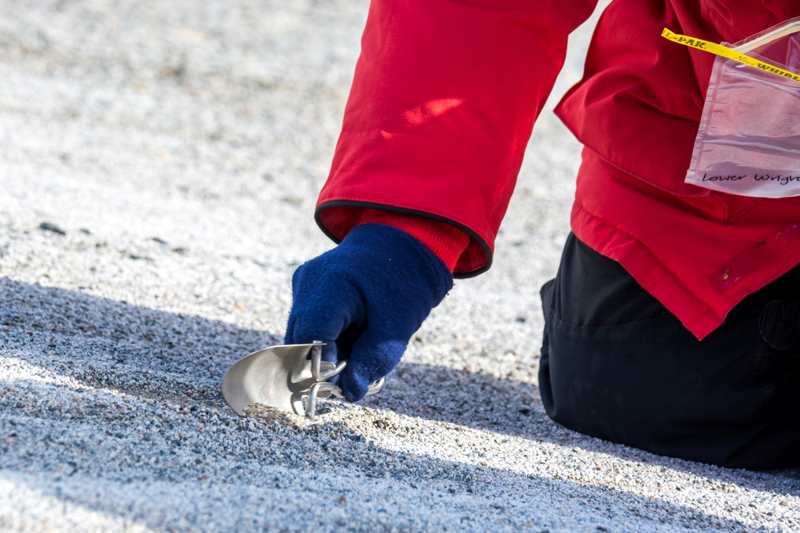
Photo Credit: Mike Lucibella
Ron Sletten bends over and samples one of the salty deposits located throughout the Wright Valley.
“Salt” is a general term chemists use to describe a range of ionic compounds formed when an acid and a base combine. Table salt and sea salt are sodium chloride, but the salt that has been accumulating at Don Juan pond is calcium chloride, the same chemical that’s often used as a deicer on highways. Figuring out the peculiar chemistry of the small pond, and the processes that sustain it, is the main focus of Sletten and his team. “We still don’t know why calcium chloride is so enriched there,” Sletten said. “Hopefully by looking at other areas, potentially where there’s calcium-chloride enrichment, will give us hints into the processes that are going on. Whether it’s an accumulation process or a process reacting to the salts.” It’s not just the presence of the calcium chloride that’s unusual either. The chemical composition of the minerals feeding into the lake hint that it should be laden with magnesium, potassium and sodium as well, but there’s a surprising lack of elements that should be there. “Don Juan Pond has very low concentrations of other [elements], in particular magnesium and potassium,” said Jonathan Toner, an Earth Science professor at the University of Washington. “It’s orders of magnitude different from any other surface water you get in Wright valley.” It’s a kind of chemical detective story, one the team investigated by collecting samples not just from the pond itself, but also from around the surrounding valley where water is thought to be seeping in and out of it. 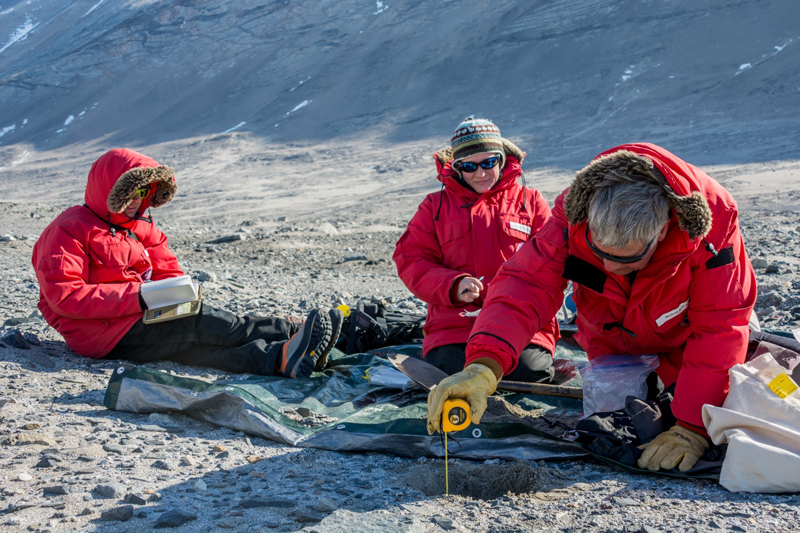
Photo Credit: Mike Lucibella
(Left to right) Jonathan Toner, Lindsay Davidge and Ron Sletten dig a small sampling hole in the Wright Valley to take soil samples at different depths.
“You should be able to accumulate calcium chloride, and remove the sodium and magnesium, but then it’s got to go somewhere. Presumably it goes into the secondary minerals,” Sletten said. This lack of elements challenges scientist’s established understanding about the salt buildup in the pond. The original presumption about how Don Juan Pond became so salty was a relatively simple idea. Water streamed into the small pond, collecting salt as it flowed then during the summer as sunlight shone on the pond, the water evaporated leaving the salt behind. But Sletten says there has to be more to it, the chemistry doesn’t quite work without something else going on. “It’s not just evaporation of surface waters, there’s more going on that causes you to get the accumulation of calcium and the depletion of sodium and magnesium,” Sletten said. By analyzing the region down valley from the pond, Sletten and his team are looking for where the magnesium and potassium might be going. In addition, they also took samples of dark streaks oozing down from the sides of the nearby cliffs, thought to be water feeding into the pond. Sletten and his team want to know more about them not just because they offer insights into what’s flowing into the pond. “There’s some interest in these also because of on Mars are these wetted streaks, and there’s some idea that these streaks might be because of concentrated brines,” Sletten said. 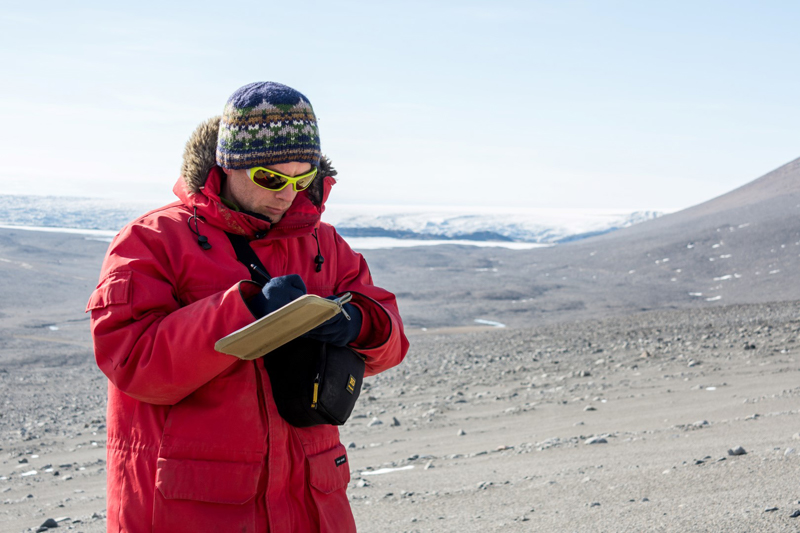
Photo Credit: Mike Lucibella
Jonathan Toner marks down notes while his team is looking for samples in the Wright Valley.
Because the streaks down the Wright Valley look so similar to those found on Mars, some researchers think they could be similar processes. However, neither have been fully studied and it’s unclear whether they really are the same. “You have to ask the next questions: Are they really the same or are they just similar looking?” Sletten said. “We’re going to sample them as much as we can.” The team collected samples of the streaks from the slopes below the cliff faces to study in the lab. Though no easy task itself in Antarctica, it has the advantage of allowing scientists to be more hands-on; collecting samples on Mars involves satellites that take measurements of the wet streaks from orbit. “On Mars our ability to actually measure on the ground is obviously limited, so in order to better interpret the readings we get from orbital data on Mars, let’s try to take spectra here on Earth where we think we know what’s going on, and then see how that compares to what we see on Mars,” said Amit Mushkin, a geologist at the University of Washington. Scientists can tell the composition of materials by breaking down the light they reflect and looking for the distinguishing gaps in their spectral signature. In effect, every element has its own unique spectral fingerprints, so scientists can tell the atomic makeup of these streaks both in the lab and from orbit. There’s a number of ways that the research team will be using the natural processes within the Dry Valleys as a sort of dry run for any human exploration of the features on Mars. “The instrument I will be using in the field, we have pretty much a replica of that on the Mars Curiosity Rover,” said Doug Ming, a planetary scientist at NASA’s Johnson Space Center. “I want to see what the materials are here because I think there’s a lot of similarity in the mineralogy.” Different than Mushkin ‘s spectroscopy, Ming’s x-ray diffraction bombards a crushed mineral sample with high-energy x-rays to determine its crystal structure. “It’s been working incredibly on Mars, we’ve been getting some phenomenal data back,” Ming said. Now, back at their respective home institutions, the team is working to analyze all of the samples they collected and see if they can decode the complicated chemistry that’s taking place within the Wright Valley. “It’s not a dead system. It’s a live, viable hydrological, biological, geochemical system and it all interacts,” Sletten said. “Down here it’s a system that some say is simpler, and it is simpler, but there’s still a lot going on.” NSF-funded research in this story: Ronald Sletten, the University of Washington, Award No. 1643550. |
"News about the USAP, the Ice, and the People"



For USAP Participants |
For The Public |
For Researchers and EducatorsContact UsNational Science FoundationOffice of Polar Programs Geosciences Directorate 2415 Eisenhower Avenue, Suite W7100 Alexandria, VA 22314 Sign up for the NSF Office of Polar Programs newsletter and events. Feedback Form |

